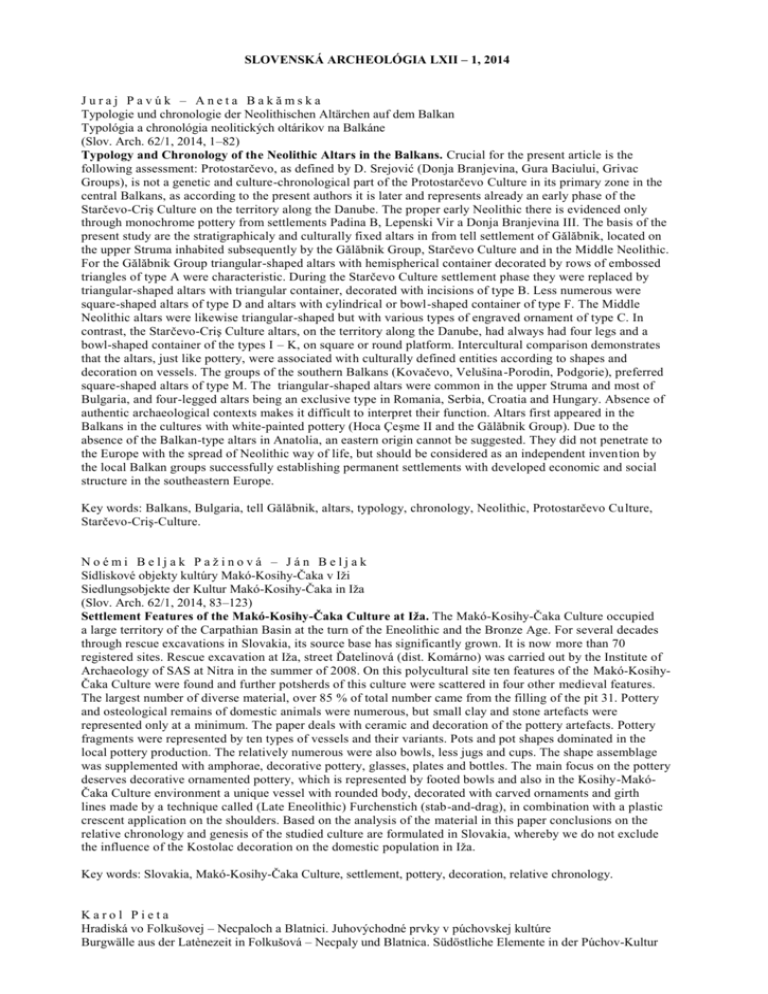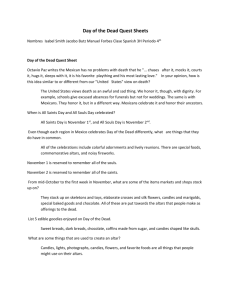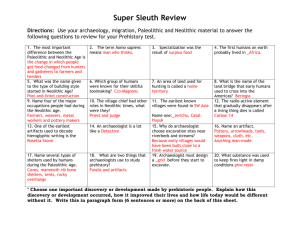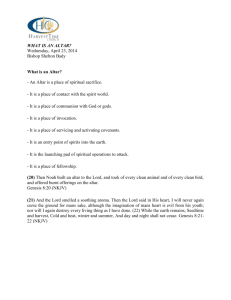SLOVENSKÁ ARCHEOLÓGIA LIX
advertisement

SLOVENSKÁ ARCHEOLÓGIA LXII – 1, 2014 Juraj Pavúk – Aneta Bakămska Typologie und chronologie der Neolithischen Altärchen auf dem Balkan Typológia a chronológia neolitických oltárikov na Balkáne (Slov. Arch. 62/1, 2014, 1–82) Typology and Chronology of the Neolithic Altars in the Balkans. Crucial for the present article is the following assessment: Protostarčevo, as defined by D. Srejović (Donja Branjevina, Gura Baciului, Grivac Groups), is not a genetic and culture-chronological part of the Protostarčevo Culture in its primary zone in the central Balkans, as according to the present authors it is later and represents already an early phase of the Starčevo-Criş Culture on the territory along the Danube. The proper early Neolithic there is evidenced only through monochrome pottery from settlements Padina B, Lepenski Vir a Donja Branjevina III. The basis of the present study are the stratigraphicaly and culturally fixed altars in from tell settlement of Gălăbnik, located on the upper Struma inhabited subsequently by the Gălăbnik Group, Starčevo Culture and in the Middle Neolithic. For the Gălăbnik Group triangular-shaped altars with hemispherical container decorated by rows of embossed triangles of type A were characteristic. During the Starčevo Culture settlement phase they were replaced by triangular-shaped altars with triangular container, decorated with incisions of type B. Less numerous were square-shaped altars of type D and altars with cylindrical or bowl-shaped container of type F. The Middle Neolithic altars were likewise triangular-shaped but with various types of engraved ornament of type C. In contrast, the Starčevo-Criş Culture altars, on the territory along the Danube, had always had four legs and a bowl-shaped container of the types I – K, on square or round platform. Intercultural comparison demonstrates that the altars, just like pottery, were associated with culturally defined entities according to shapes and decoration on vessels. The groups of the southern Balkans (Kovačevo, Velušina-Porodin, Podgorie), preferred square-shaped altars of type M. The triangular-shaped altars were common in the upper Struma and most of Bulgaria, and four-legged altars being an exclusive type in Romania, Serbia, Croatia and Hungary. Absence of authentic archaeological contexts makes it difficult to interpret their function. Altars first appeared in the Balkans in the cultures with white-painted pottery (Hoca Çeşme II and the Gălăbnik Group). Due to the absence of the Balkan-type altars in Anatolia, an eastern origin cannot be suggested. They did not penetrate to the Europe with the spread of Neolithic way of life, but should be considered as an independent inven tion by the local Balkan groups successfully establishing permanent settlements with developed economic and social structure in the southeastern Europe. Key words: Balkans, Bulgaria, tell Gălăbnik, altars, typology, chronology, Neolithic, Protostarčevo Cu lture, Starčevo-Criş-Culture. Noémi Beljak Pažinová – Ján Beljak Sídliskové objekty kultúry Makó-Kosihy-Čaka v Iži Siedlungsobjekte der Kultur Makó-Kosihy-Čaka in Iža (Slov. Arch. 62/1, 2014, 83–123) Settlement Features of the Makó-Kosihy-Čaka Culture at Iža. The Makó-Kosihy-Čaka Culture occupied a large territory of the Carpathian Basin at the turn of the Eneolithic and the Bronze Age. For several decades through rescue excavations in Slovakia, its source base has significantly grown. It is now more than 70 registered sites. Rescue excavation at Iža, street Ďatelinová (dist. Komárno) was carried out by the Institute of Archaeology of SAS at Nitra in the summer of 2008. On this polycultural site ten features of the Makó-KosihyČaka Culture were found and further potsherds of this culture were scattered in four other medieval features. The largest number of diverse material, over 85 % of total number came from the filling of the pit 31. Pottery and osteological remains of domestic animals were numerous, but small clay and stone artefacts were represented only at a minimum. The paper deals with ceramic and decoration of the pottery artefacts. Pottery fragments were represented by ten types of vessels and their variants. Pots and pot shapes dominated in the local pottery production. The relatively numerous were also bowls, less jugs and cups. The shape assemblage was supplemented with amphorae, decorative pottery, glasses, plates and bottles. The main focus on the pottery deserves decorative ornamented pottery, which is represented by footed bowls and also in the Kosihy-MakóČaka Culture environment a unique vessel with rounded body, decorated with carved ornaments and girth lines made by a technique called (Late Eneolithic) Furchenstich (stab-and-drag), in combination with a plastic crescent application on the shoulders. Based on the analysis of the material in this paper conclusions on the relative chronology and genesis of the studied culture are formulated in Slovakia, whereby we do not exclude the influence of the Kostolac decoration on the domestic population in Iža. Key words: Slovakia, Makó-Kosihy-Čaka Culture, settlement, pottery, decoration, relative chronology. Karol Pieta Hradiská vo Folkušovej – Necpaloch a Blatnici. Juhovýchodné prvky v púchovskej kultúre Burgwälle aus der Latènezeit in Folkušová – Necpaly und Blatnica. Südöstliche Elemente in der Púchov-Kultur (Slov. Arch. 62/1, 2014, 125–165) La Tène Hill-forts in Folkušová – Necpaly and Blatnica. In Turiec region, in northern Slovakia are two agglomerations of hill-forts and settlements that provided remarkable finds from the Middle La Tène Period to the beginning of the Roman Period, from the pre-Púchov stage and the La Tène phase of the Puchov Culture. It is a system of terraced settlements and fortified refugia on the hilltops of mountains in Folkušová – Necpaly and Blatnica. In the Early to the Middle La Tène Periods and the Early Roman Period Blatnica was the regional centre. Both centres were used at the time of the largest settlement expansion in northern Carpathians, from the Middle La Tène Period to the beginning of Roman Period, when they became extinct violently. A special feature of both agglomerations is long-term use, preservation state of old roads and combination of terraced settlements with fortifications on inaccessible peaks with great altitudes. Hoards of La Tène swords are the continuation of long tradition of sacrificial places around the hilltop Plešovica, which is enclosed with the Early Medieval princely grave. The study also observes a number of artefacts that document the connection of northern Slovakia with southeastern Europe in the Late La Tène Period. Key words: Northern Slovakia, Turiec Region, Bronze Age, La Tène Period, Early Roman Period, Púchov Culture, Hill-forts, Centre of Power, Old Roads, Hoards, Cultic Places, Southearstern Influences. Péter Prohászka Das germanische Gräberfeld von „Dunajská Streda“ Germánske pohrebisko v Dunajskej Strede (Slov. Arch. 62/1, 2014, 167–198) The German Cemetery of “Dunajská Streda”. The article deals with the German and Roman finds from the cemetery of Dunajská Streda. Some finds are known from the books of J. Eisner and E. Beninger only. According to Beninger these finds are from two different localities. The local pharmacist’s, Iván László’s letter with some drawings of the finds dug in 1894 helps us to locate the cemetery and to clarify its chronology. Based on this letter the cemetery was in the confines of Malé Dvorníky, and not in Dunajská Streda. In his letter Iván László described seven graves (urn and skeleton graves as well) together with the grave-goods. Ceramic pots and urns, Roman and German brooches, a Roman bronze vessel, and other objects are amongst the drawn finds. The earliest finds belong to the periods B1b and B1c. These are an Almgren 45 iron brooch, an Almgren 68 strong profiled brooch, and a fragment of an Almgren 236 brooch. To the periods B1c and B2 belong some ceramic urns, an Eggers 155 bronze casserole, a trumpet brooch, an Almgren V/2 iron brooch, and strap mountings from drinkinghorns. A bowl, a Barbarian imitation of a ‘Faltenbecher’, and two urns are from the 3 rd century (period C2). To the C3 period belong a ceramic pottery, a bowl, a bead, and an Almgren group VI brooch. On the basis of the gravegoods the cemetery was opened in the first half of the 1 st cent. A. D. and was used to the mid-2nd cent. A. D. In the 3rd cent. it was reopened. A part of the urn and skeleton graves are certainly from the early Roman period, but some of the graves (e. g. grave ‘E’) are burials from the 3 rd – 4th cent. From the point of view of the burial rituals and the finds the cemetery of “Dunajská Streda”/Malé Dvorníky is related to the cemeteries of South-West Slovakia (Abrahám, Kostolná pri Dunaji, Sládkovičovo), but only the cemetery of “Dunajská Streda”/Malé Dvorníky was reopened in the late Roman period. This cemetery was used by the Quadi, a smaller Germanic tribe settled on the Žitný ostrov already in the early 1st cent. A. D. Key words: South-West Slovakia, Roman period, Germans, graves, chronology, archival records. Správa Milan Hanuliak: 45. medzinárodná konferencia archeológie stredoveku (Slov. Arch. 62/1, 2014, 199–201) Recenzie Milan Hanuliak: Pavel Kouřil – Markéta Tymonová: Slovanský kostrový mohylník ve Stěbořicích (Slov. Arch. 62/1, 2014, 203–205) Vladimír Mitáš: Immo Heske – Barbara Horejs (Hrsg.): Bronzezeitliche Identitäten und Objekte (Slov. Arch. 62/1, 2014, 205–208) Susanne Stegmann-Rajtár: Michaela Lochner – Florian Ruppenstein (Hrsg.): Brandbestattungen von der mittleren Donau bis zur Ägäis zwischen 1300 und 750 v. Chr. (Slov. Arch. 62/1, 2014, 208–211)








